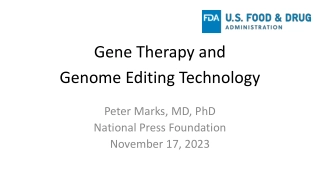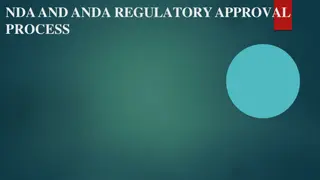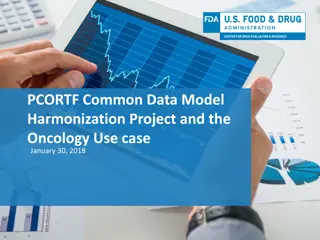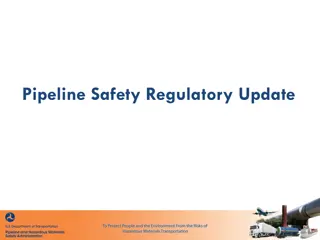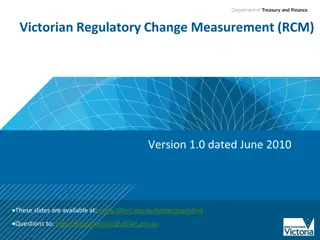Examples of Real-World Evidence in Regulatory Decisions by FDA
FDA showcases illustrative examples of how Real-World Evidence (RWE) has been utilized in regulatory decisions, highlighting its value across different submission types, data sources, and purposes from FY12-FY19. The FDA report features cases like a modified hemodialysis catheter end cap, tumor profiling test with EHR data, and a total ankle replacement system utilizing registry data.
Download Presentation

Please find below an Image/Link to download the presentation.
The content on the website is provided AS IS for your information and personal use only. It may not be sold, licensed, or shared on other websites without obtaining consent from the author. Download presentation by click this link. If you encounter any issues during the download, it is possible that the publisher has removed the file from their server.
E N D
Presentation Transcript
Illustrative Examples of RWE Used in Illustrative Examples of RWE Used in Regulatory Decisions Regulatory Decisions Felipe Aguel, PhD Deputy Directory Office of Clinical Evidence and Analysis Office of Product Evaluation and Quality CDRH
Why? Why? FDA is committed to advancing evidence generation with relevant and reliable RWE across the TPLC for timely regulatory decision making Showcase concrete examples to demonstrate that regulatory decisions can and have been made by CDRH based on RWE Single place for stakeholders to see and learn from past experience Intent: encourage the continued and expanded use of RWE for regulatory decisions 2
What? What? FDA published a report of 90 publicly available examples of different types of regulatory submissions supported by RWE. Accompanied by an FDA voices piece about RWE highlighted the value and spectrum of RWE for device regulatory decision making www.fda.gov
How? How? No flag to indicate RWE; relied on other flags to narrow scope and then conducted a manual review of many submissions to identify illustrative examples to showcase. Included examples from FY2012-2019 Not all-inclusive. There are more examples than the 90 included in the report. 4
RWE in Submissions RWE in Submissions Between FY12-FY19, CDRH relied on RWE to advance submissions, including: Variety of submission types (i.e., 510(k), De Novo, PMA, HDE) Variety of data sources (e.g., registries, medical records, claims, device generated data) Variety of purposes (e.g., new authorization, indication expansion, postmarket study) These examples come from full continuum of clinical and device areas throughout all seven Offices of Health Technology (OHT) within CDRH, e.g., Three examples of digital health devices, demonstrating validation of SaMD using RWD Two examples using patient-generated data; nine examples using device-generated data One example that used a clinical trial embedded in a registry Building on learnings from this effort and others, CDRH will continue to evaluate how RWD and RWE can be used to efficiently inform regulatory decision-making
A Few Case Examples A Few Case Examples 510k for a modified IFU for a hemodialysis catheter end cap to include information related to reduction of bloodstream infections De Novo for a NextGen sequencing-based tumor profiling test with EHR data to support a pan-cancer claim. PMA for a total ankle replacement system that used registry data as a primary source of data for premarket approval and to support a PAS as a condition-of-approval. 6
By Submission Type By Submission Type HDE, 2 De Novo, 14 PMA Panel- Track, 37 510(k), 18 PMA, 20
By Data Source By Data Source Patient-generated data 2% Other 17% Medical records (EHR, EMR, or chart review) 21% Device-generated data 8% Sponsor registry 20% Non-sponsor registry & admin. Claims 13% Non-sponsor registry 19%
By Use (pre By Use (pre- -market) market) Comparator, 1 Control, 3 Device Clearance, 5 Sole source, 12 New Indication, 26 Supplementary/ secondary source, 14 Primary source, 39 Labeling Expansion/ Modification, 30
A step back A step back Decisions using RWE are not new to CDRH Some examples pre-date CDRH RWE guidance Upward trend in use of RWE For each example, CDRH assessed the relevance and reliability the RWE Determined RWE acceptable in evaluating the totality of available data The 90 examples only included information available in the public domain I.e., only cases where RWE was deemed to be relevant and reliable for the context of use
Relevance: Relevance: a critical component of CDRH review a critical component of CDRH review In 90 examples, relevance established and largely dependent on context of use. Relevance (and usability) an RWE study and its patient population, endpoints, and duration of follow-up depend on context of use. Informing clinical study design Substantial equivalence Pre-market benefit/risk determinations Post-market surveillance
Relevance: Relevance: a critical component of CDRH review a critical component of CDRH review In 90 examples, relevance established and largely dependent on context of use. Relevance (and usability) an RWE study and its patient population, endpoints, and duration of follow-up depend on context of use. Informing clinical study design Substantial equivalence Pre-market benefit/risk determinations Post-market surveillance Reimbursement FDA/CDRH }
Reliability & data quality: Reliability & data quality: also critical components of CDRH review also critical components of CDRH review Poor quality data likely not usable for decision-making, regardless of relevance, and regardless of purpose Well-defined standards for RWD quality are critical Applied consistently within the medical device ecosystem Leverage data sources for multiple purposes Common understanding of what good looks like FDA is working with MDIC, NEST, and other stakeholders to develop metrics, maturity models, and standards for data quality


